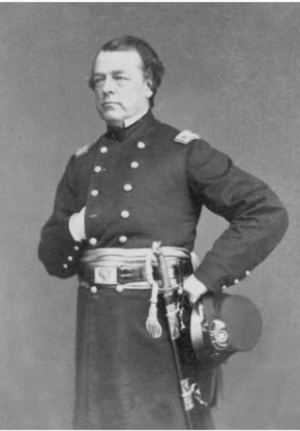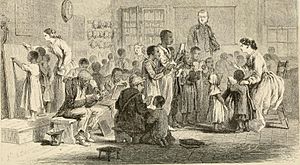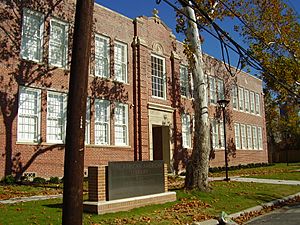Edgar M. Gregory facts for kids
Quick facts for kids
Edgar Mantlebert Gregory
|
|
|---|---|

Edgar M. Gregory during the American Civil War
|
|
| Born | January 1, 1804 Sand Lake, New York, U.S. |
| Died | November 7, 1871 (aged 67) Philadelphia, Pennsylvania, U.S. |
| Place of burial |
Laurel Hill Cemetery, Philadelphia
|
| Allegiance | United States (Union) |
| Service/ |
Union Army |
| Years of service | 1861–1867 |
| Rank | |
| Commands held | 91st Pennsylvania Infantry Regiment 2nd Brigade, 1st Division, V Corps Assistant Commissioner, Freedmen's Bureau Texas Assistant Commissioner, Freedmen's Bureau Maryland |
| Battles/wars | American Civil War |
| Other work | U.S. Marshal, businessman, pastor |
Edgar Mantlebert Gregory (born January 1, 1804 – died November 7, 1871) was an important figure in American history. He served as an officer in the Union Army during the American Civil War. After the war, he became an official with the Freedmen's Bureau, an organization that helped formerly enslaved people. Gregory was also known for being an abolitionist, someone who worked to end slavery.
Before the war, he worked in businesses like lumber, banking, and railroads. He also played a role in the Underground Railroad, helping people escape slavery to freedom. During the war, he showed great bravery and skill, rising to the rank of Brevet major general. After the war, he worked to protect the rights of newly freed African Americans.
Contents
Early Life and Work
Edgar Mantlebert Gregory was born on January 1, 1804, in Sand Lake, New York. He grew up in Pennsylvania. His father was Rev. Justus Gregory and his mother was Clarissa Downs. His family had ancestors who came from England and were early settlers in Connecticut.
Gregory had two brothers, Henry and David, and some older sisters. For a time, he lived in Deposit, New York.
Pre-War Career and Activism
In 1832, Gregory helped start the Deposit Bridge Company. Later, he moved to Cincinnati, Ohio, where he worked in the railroad, lumber, and banking industries. While in Cincinnati, he actively helped people who were escaping slavery find their way to Canada through the Underground Railroad.
He was also involved in religious and charitable groups. By 1844, he was the treasurer for the American Home Missionary Society. In 1846, he led the Cincinnati Young Men's Auxiliary of the American Bible Society. Eventually, he moved to Philadelphia, Pennsylvania, where he became a preacher. He also helped create the Home Guards, a local militia group in Philadelphia.
Service in the Civil War
During the American Civil War, Edgar Gregory joined the Union Army. His two sons also joined the army and served until the war ended.
Joining the Union Army
On August 2, 1861, Gregory became a colonel in the 91st Pennsylvania Infantry Regiment. This regiment fought in many important battles, a total of 21 throughout the war.
Key Battles and Promotions
Gregory was wounded in the leg on March 3, 1863, during the Battle of Chancellorsville. He and his troops also fought bravely at Little Round Top during the famous Battle of Gettysburg. In August 1864, he led his troops during the Richmond campaign, which included fighting near Weldon Railroad.
He was promoted to brigadier general on September 30 or October 17, 1864, for his "gallant and distinguished service" at the Battle of Poplar Springs Church.
End of the War and Later Orders
Gregory and his regiment were present at the Battle of Appomattox Court House, where the Confederate Army surrendered. After this, he took command of the Second Brigade, New York Volunteers, which was part of the 5th Corps.
On June 23, 1865, as the war was ending, Gregory issued an important order. He declared that "People of color . . . [should have] the same personal liberty that other citizens and inhabitants enjoy." This order was supported by General Oliver Otis Howard.
His regiment was officially dismissed from service in July 1865. Gregory was promoted again to major general on August 9, 1865, or 1866, for his "gallant conduct" at the Battle of Five Forks. He left the army on November 30, 1867.
Work with the Freedmen's Bureau
After the Civil War, Gregory played a vital role in the Freedmen's Bureau. This organization was created to help formerly enslaved people adjust to their new freedom.
Challenges for Freed People in Texas
After slavery ended, many African Americans in Texas faced serious challenges. Some white people continued to treat them like slaves, forcing them to work without pay. There were also groups of white gunmen who attacked black people who tried to leave the state. Some were even kidnapped and sold into slavery in other countries.
Gregory's Role in Texas
Gregory was appointed as the assistant commissioner for the Freedmen's Bureau in Texas. He was known for being fearless and a strong abolitionist. He traveled to plantations in eastern Texas to see how black people were being treated. He found that they were still being treated very cruelly, with incidents ranging from beatings to murder.
Gregory believed that African Americans were respectable and deserved to live freely. He talked to both white and black people about their new freedom and the process of reconstruction. He explained that black people would not receive land from former slaveholders or the government.
To help manage the labor situation, he created labor contracts between freed people and their former owners. These contracts helped set fair terms for work and payment. He also appointed local agents to help solve disagreements. Gregory even had Army troops patrol plantations to make sure the contracts were followed.

He also oversaw the building of many schools and churches for African Americans. However, Gregory was removed from his position in January 1866. Some white leaders, like David Burnet, complained that Gregory was making freed people angry at their employers. Gregory received praise for his service and was promoted to inspector general before leaving his role in Texas.
Helping Children in Maryland
In 1867, Gregory became the commissioner for Maryland. At this time, many black children were still forced into illegal apprenticeships, where they were bonded to former masters. This made it hard for them to get an education or enjoy their civil rights. It was estimated that about 10,000 children were held in these apprenticeships.
Under Gregory's leadership, these illegal apprenticeships were largely ended in Maryland by 1868. The Bureau also provided money to build and repair school buildings for black children. They also supplied educational materials. Religious and community groups helped provide teachers for these schools.
United States Marshal
On May 11, 1869, President Ulysses S. Grant appointed Gregory to a new role. He became the United States Marshal for the Eastern District of Pennsylvania. He served in this position until he passed away.
Personal Life and Legacy
Edgar Gregory married Ellen Young. She was born around 1807 and passed away in 1868. They had three children: Frances Henry, Justus Abram, and Sarah Augustus.
Gregory was a member of the Republican Party and a Mason. He was also a Presbyterian. His health became weaker due to the leg injury he got during the Civil War. He died on November 7, 1871, at the age of 68.
His funeral was a private event at his home in Philadelphia. A military escort, including men who had served under him, took his hearse to the Oxford Presbyterian Church for a public service. Many important people, including clergy, judges, and military officials, attended his funeral. He and his wife were buried at the South Laurel Hill Cemetery.
Edgar M. Gregory School

A school in Houston, Texas, was named after him: the Edgar M. Gregory School. This was the first school for African American children in Houston. Today, it is known as the African American Library at the Gregory School. It is one of the few libraries specifically for black history and culture. It is located in the Freedmen's Town National Historic District in Houston.
See also
- List of American Civil War brevet generals (Union)

